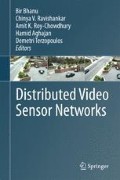Abstract
A novel method is presented for distributed matching of curves across widely varying viewpoints. The fundamental projective joint-invariants for curves in the real projective space are the volume cross ratios. A curve in m-dimensional projective space is represented by a signature manifold comprising n-point projective joint invariants, where n is at least m+2. The signature manifold can be used to establish equivalence of two curves in projective space. However, without correspondence information, matching signature manifolds is a computational challenge. Our approach in this chapter is to first establish best possible correspondence between two curves using sections of the invariant signature manifold and then perform a simple test for equivalence. This allows fast computation and matching while keeping the descriptors compact. The correspondence and equivalence of curves is established independently at each camera node. Experimental results with simulated as well as real data are provided.
Access this chapter
Tax calculation will be finalised at checkout
Purchases are for personal use only
References
Arora, R., Hu, Y.H., Dyer, C.R.: Estimating correspondence between multiple cameras using joint invariants. In: Proc. Int. Conf. Acoust., Speech and Signal Process (2009)
Astrom, K., Morin, L.: Random cross ratios. In: Proc. 9th Scand. Conf. Image Anal., pp. 1053–1061 (1995)
Chum, O., Philbin, J., Zisserman, A.: Near duplicate image detection: min-hash and tf-idf weighting. In: Proc. British Mach. Vision Conf. (2008)
Clarot, P., Ermis, E.B., Jodoin, P.M., Saligrama, V.: Unsupervised camera network structure estimation based on activity. In: Proc. 3rd ACM/IEEE Int. Conf. Dist. Smart Cameras (2009)
Collins, R., Lipton, A., Fujiyoshi, H., Kanade, T.: Algorithms for cooperative multisensor surveillance. Proc. IEEE 89(10), 1456–1477 (2001)
Fischler, M.A., Bolles, R.C.: Random sample consensus: a paradigm for model fitting with applications to image analysis and automated cartography. Commun. ACM 24, 381–395 (1981)
Hann, C.E.: Recognizing two planar objects under a projective transformation. PhD dissertation, Univ. of Canterbury (2001)
Hann, C.E., Hickman, M.S.: Recognising Two Planar Objects under a Projective Transformation. Kluwer Academic, Dordrecht (2004)
Hu, W., Tan, T., Wang, L., Maybank, S.: A survey on visual surveillance of object motion and behaviors. IEEE Trans. Syst. Man Cybern. Part C, Appl. Rev. 34(3), 334–352 (2004)
Huynh, D.Q.: The cross ratio: a revisit to its probability density function. In: Proc. 11th British Machine Vision Conf. (2000)
Lee, L., Romano, R., Stein, G.: Monitoring activities from multiple video streams: establishing a common coordinate frame. IEEE Trans. Pattern Anal. Mach. Intell. 22(8), 758–767 (2000)
Lowe, D.: Object recognition from local scale-invariant features. In: Proc. 7th Int. Conf. Computer Vision, pp. 1150–1157 (1999)
Marhic, B.M., Mouaddib, E.M., Pegard, C.: A localisation method with an omnidirectional vision sensor using projective invariant. In: Proc. Int. Conf. Intelligent Robots Systems, pp. 1078–1083 (1998)
Mariottini, G., Prattichizzo, D.: EGT for multiple view geometry and visual serving. IEEE Robot. Autom. Mag. 12(4), 26–39 (2005)
Maybank, S.J.: Probabilistic analysis of the application of the cross ratio to model based vision. Int. J. Comput. Vis. 14, 199–210 (1995)
Mundy, J.L., Zisserman, A. (eds.): Geometric Invariance to Computer Vision. MIT Press, Cambridge (1992)
Mundy, J.L., Zisserman, A., Forsyth, D. (eds.): Applications of Invariance in Computer Vision. Springer, Berlin (1993)
Olver, P.J.: Joint invariant signatures. Found. Comput. Math. 1, 3–67 (2001)
Orrite, C., Blecua, S., Herrero, J.E.: Shape matching of partially occluded curves invariant under projective transformation. Comput. Vis. Image Underst. 93, 34–64 (2004)
Remagnino, P., Velastin, S., Foresti, G., Trivedi, M.: Novel concepts and challenges for the next generation of video surveillance systems. Mach. Vis. Appl. 18(3), 135–137 (2007)
Roh, K.S., Lee, W.H., Kweon, I.S.: Obstacle detection and self-localization without camera calibration using projective invariants. In: Proc. Int. Conf. Intelligent Robots and Systems, pp. 1030–1035 (1997)
Rothwell, C.A., Zisserman, A., Forsyth, D.A., Mundy, J.L.: Canonical frames for planar object recognition. In: Proc. 2nd European Conf. Computer Vision (1992)
Rothwell, C.A., Zisserman, A., Forsyth, D.A., Mundy, J.L.: Planar object recognition using projective shape representation. Int. J. Comput. Vis. 16, 57–99 (1995)
Shashua, A.: A geometric invariant for visual recognition and 3D reconstruction from two perspective/orthographic views. In: Proc. IEEE Workshop on Qualitative Vision, pp. 107–117 (1993)
Snavely, N., Seitz, S., Szeliski, R.: Photo tourism: exploring photo collections in 3D. ACM Trans. Graph. 25(3), 835–846 (2006) (Proc. SIGGRAPH)
Tsonis, V.S., Chandrinos, K.V., Trahanias, P.E.: Landmark-based navigation using projective invariants. In: Proc. Int. Conf. Intell. Robots Systems, pp. 342–347 (1998)
Velipasalar, S., Wolf, W.: Frame-level temporal calibration of video sequences from unsynchronized cameras by using projective invariants. In: Proc. Advanced Video Signal-based Surveillance, pp. 462–467 (2005)
Wisconsin Computer Vision Group: Repository for joint-invariant matching. http://www.cae.wisc.edu/~sethares/links/raman/JICRvid/space.html
Author information
Authors and Affiliations
Corresponding author
Editor information
Editors and Affiliations
Rights and permissions
Copyright information
© 2011 Springer-Verlag London Limited
About this chapter
Cite this chapter
Arora, R., Dyer, C.R. (2011). Projective Joint Invariants for Matching Curves in Camera Networks. In: Bhanu, B., Ravishankar, C., Roy-Chowdhury, A., Aghajan, H., Terzopoulos, D. (eds) Distributed Video Sensor Networks. Springer, London. https://doi.org/10.1007/978-0-85729-127-1_3
Download citation
DOI: https://doi.org/10.1007/978-0-85729-127-1_3
Publisher Name: Springer, London
Print ISBN: 978-0-85729-126-4
Online ISBN: 978-0-85729-127-1
eBook Packages: Computer ScienceComputer Science (R0)

